

The slow movement of Jupiter along the ecliptic makes its opposition (and prime imaging season) about one month later every year. This year, the season started just about the first of the year. I'll continue to take images until the planet disappears into the San Diego fog in May. Hopefully, I'll get even better images than last year, with the 10" Newtonian all tuned up and ready for good seeing!
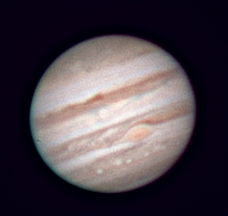
Seeing was average, but after sorting through lots of images taken this evening, one good image was saved. The turbulence surrounding the Great Red Spot seems even more active than last year, and the GRS itself seems a little more colorful. These images were taken with 2 second exposures. Note that the tilt is substantially different from last year's images; another consequence of its path along the ecliptic (the camera and telescope have a fixed orientation).
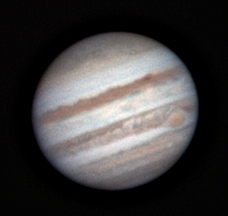
As an experiment in trading off between short exposures and noise generation during processing, this image during good seeing used longer exposures; 4 seconds (Red and Green filters) and 8 seconds (Blue filter). The signal is twice the normal signal, so it should tolerate more processing. Blur due to translation is minimized with the AO-2, but higher-order distortions cause a worse-looking initial image. The question still remains if the better average seeing over a shorter period is made up by the increase in noise generated by image processing. The related question is for how long the seeing is better than average; is 4 seconds long enough to fully average the seeing, and is 8 seconds any worse? More data is required; for now, exposures of 2sec/2sec/4sec for RGB exposures will be used..
In the early evening of March 6, Ganymede came within 2.6 arcsec of Europa, not far from Jupiter. Ganymede was only 1.62 arcsec in diameter and Europa was only 0.96 arcsec in diameter, so the disk edges were only 1.3 arcsec apart at closest approach. Since Jupiter was too far away, the AO-2 could not be used to stabilize the images, so pictures were taken as rapidly as possible (about 6 seconds apart) and the best ones were made into a short movie. Since using the filter wheel would have taken too much time, all images were taken in green light. This color gives pretty good contrast on Jupiter's disk as well as surface features on Ganymede, since the green filter lets more light than the blue filter and has higher resolution than the red filter. The best 26 frames, spaced about 2 minutes apart, were selected for the short movie. Each frame was a 2x binned image from the ST-7E camera at F/60 (0.25 arcsec/binned pixel), each exposure lasting 0.5 seconds, since the seeing was not above average. On some frames, surface features on Ganymede are visible. The images were processed with gentle maximum entropy processing, followed by unsharp masking, all using MaximDL. To bring out the lower brightness moons, each frame was stretched with a gamma of 0.8. You can also click on the image above to open the movie (easily viewed with Windows Media player, which continuously loops the short movie (about 374 k).
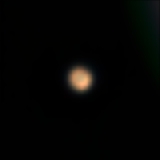
A little bit later the same evening, the seeing was not much better, but the moon approached Jupiter's limb, so the AO-2 could be used to stabilize the image. Color images were also taken, and the best few of Ganymede were combined, maximum entropy applied, then unsharp masked, to bring out the detail in Ganymede. It is subtle, but definite, and follows features shown in Guide8 software. The image was composed of about 8 frames in each color, 2 second exposures in red and green, and 4 seconds in blue. After processing, the image size was doubled to smooth the image to 8 pixels/arcsec.


At the same time as the picture above, the seeing was a little better, so a whole-frame image was composed of the best frames. The AO-2 was on, for 2 second exposures in red and green and 4 seconds in blue. The long exposure for 2x binned images gives a good signal-to-noise ratio for the subsequent maximum entropy processing and unsharp masking. A little gamma stretching was done to enhance Ganymede - a little surface shading is again seen on the left image. To bring out a little more detail on Jupiter, perhaps for comparisons with similar images on other web sites, the original image on the left was reprocessed with even more unsharp masking to the point of over-processing. That result is shown on the right. The image is not as natural looking, but the increased contrast shows subtle details in the clouds. Any more processing would make the noise even worse.

The seeing was only average, but a bigger problem was dew on the secondary mirror. Exposures were 2 seconds for red and green filters, 3 seconds for the blue filter. After this session, a longer dew cap was added to the tube and the rear mirror fan was reversed to blow air out instead of drawing air in from the top.
Lots of activity around Jupiter tonight; Callisto's shadow falling first on Jupiter, followed by a close occultation between Callisto and Io, followed by Callisto eclipsing Io.
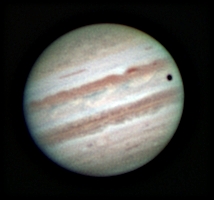
Callisto's shadow falling near Jupiter's limb at about 7:22 pm PST.
Just after 8 pm, Callisto occulted Io by the smallest of margins; 0.05 arcsec according to Guide8. The two moons just overlapped, but the images show the two moons slide by each other in this movie. Since Io was slightly smaller than Callisto, (1.11 arcseconds in diameter compared to 1.47 arcsec) and slightly brighter (magnitude 5.2 compared to magnitude 5.8), it shows up as a very bright spot in the images compared to Callisto. All the images were 2 seconds long with a green filter, the best color for highest resolution and good signal. The AO-2 could not be used for image stabilization, since Jupiter was too far away.
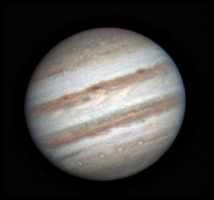
A series of white ovals near the south temperate region precede the Great Red Spot at 9:57 pm PST.
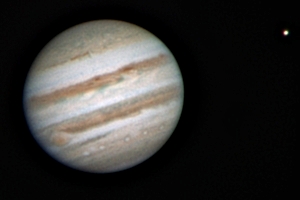
Io and the Great Red Spot come into view at 10:41 pm PST.
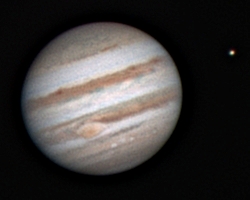
At 11:34 pm PST, the Great Red Spot approaches Jupiter's meridian while Io approaches Jupiter's edge.
While processing the long series of images, I noted that Io got rather dim as it approached Jupiter, then brightened. Since Jupiter did not dim at the same time, it couldn't have been a cloud. Looking at Guide8 a little more carefully, then referencing the tables in Sky and Telescope, I realized I had accidently recorded an eclipse of Io by Callisto! I used Jupiter as a constant magnitude reference "star", and measured Io's dimming during the RGB exposures I was taking of the Io-Jupiter pair. The magnitude drop for the three filters was combined in the plot below. Io dropped 1.5 magnitudes at mid-eclipse. The data on the right side of the graph is a little noisier because Io was getting very close to Jupiter, and the glare from Jupiter made accurate magnitude measurements a little more uncertain.
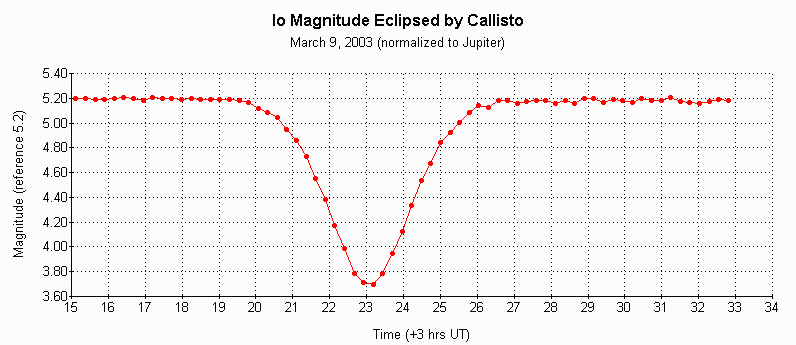
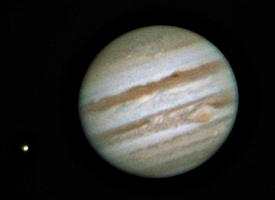
The next evening, Io was again close to Jupiter, and the Great Red Spot was conveniently placed on the other side of the meridian, giving a good view of the considerable turbulence following the spot.
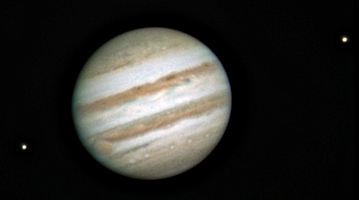
Two nights later, both Europa (left) and Io were within the camera's field of view, with the Great Red Spot just coming into view. The series of ovals in the southern hemisphere is pretty magnificent, as well as the festoon in the northern equatorial region.

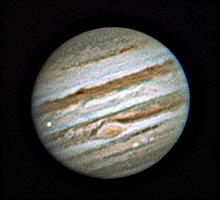
About an hour later, Europa has started crossing Jupiter's disk and the Great Red Spot is nearer the meridian. The left-hand image shows the processing I normally use; the right-hand image is over-processed with additional unsharp masking. The cloud structure in the equatorian region is a little more evident, but more processing would lead to even more noise.
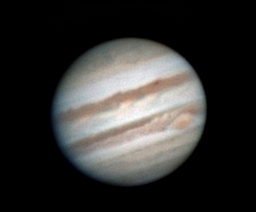
Average seeing.
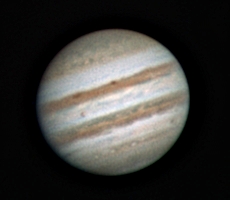

Images about 1 hour apart. Io can be seen in the left image on the equator over Jupiter, about half-way from the edge to the center. An hour later, Io has crossed over to the opposite side by the same amount, followed by its shadow where the moon was located. Io is just resolved, showing it is just a bit less bright than Jupiter's zones, but brighter than the darker belts.
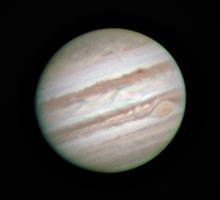

The turbulence following the Great Red Spot is especially evident in this image, as well as some interesting cloud features in the equatorial zone. The right hand image is again overprocessed to highlight the cloud features.
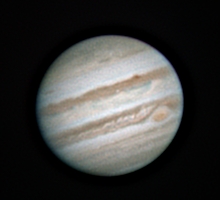
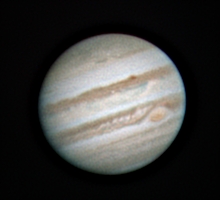
Two images taken only 10 minutes apart can be used as a stereo pair. Average seeing this evening. An attempt to image features on Ganymede was unsuccessful, partially because the moon was too far from Jupiter to use the AO-2 for image stabilization.

Jupiter, the side opposite the Great Red Spot, appears pretty bland. Earlier in the evening, however, the moons put on a good show. The frame below is the starting point for a 1 hour movie compressed to a few seconds. Click here or on the image to start the movie clip. The best 79 frames were picked out of 500 frames and assembled into the movie after each frame was recentered on Io, the moon in the upper left corner. Ganymede is the larger and brighter moon that was occulted by Europa by only 0.14 arcsec at 8:08 pm PST. Each frame was a 0.5 second exposure taken through a green filter to enhance resolution.
After the movie and the Jupiter image, a short movie of Regulus was taken to illustrate the average seeing that night. Click here to go to the page.

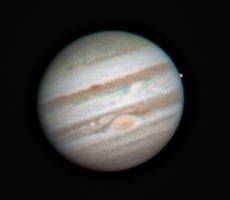
Io appears in the frame just as the Great Red Spot rotates into view, and later is just on the edge when the Great Red Spot is centered on the meridian. The seeing was just a bit above average.
All text and images are owned by Stellar Products, 1992-2003. Any use by others without permission of Stellar Products is prohibited.
Links to other Stellar Products pages: